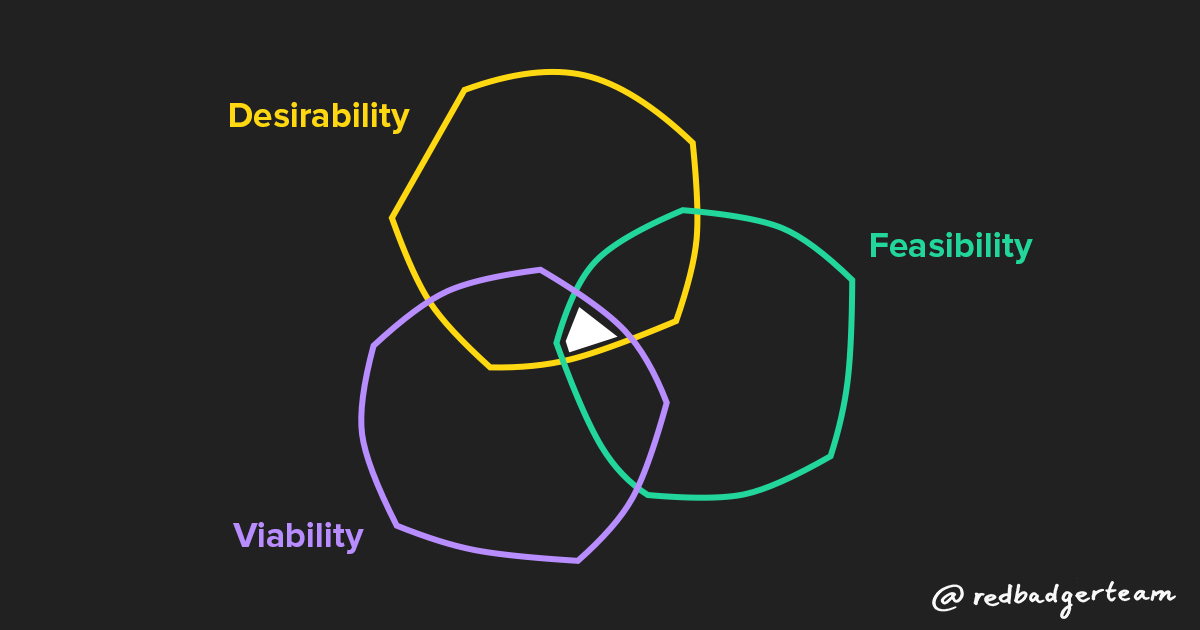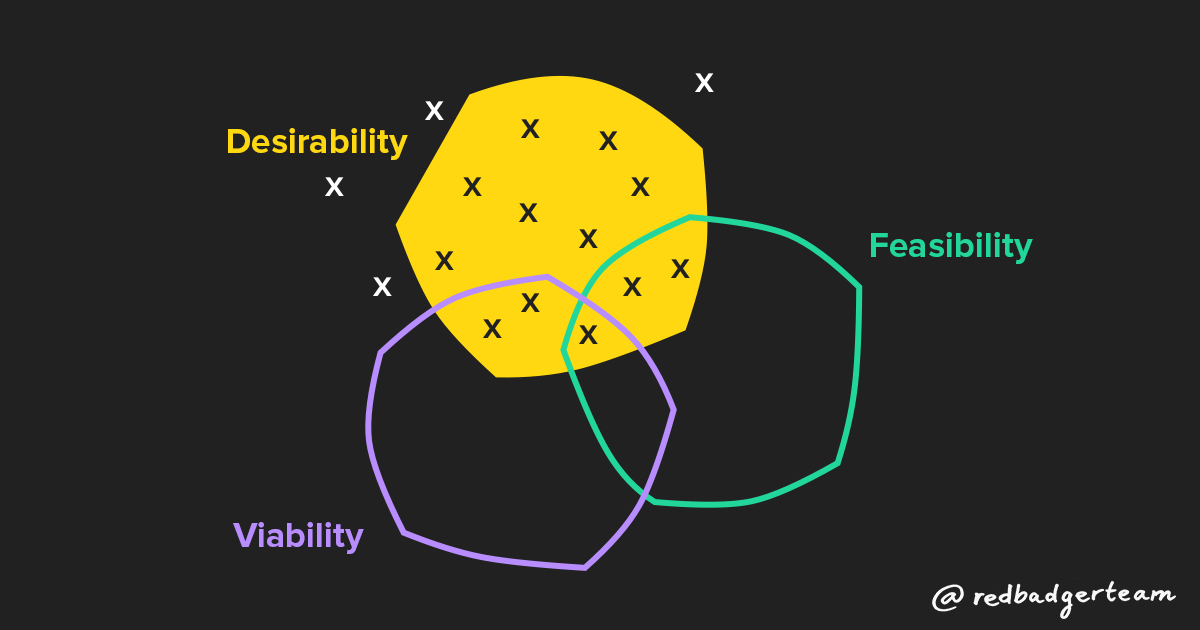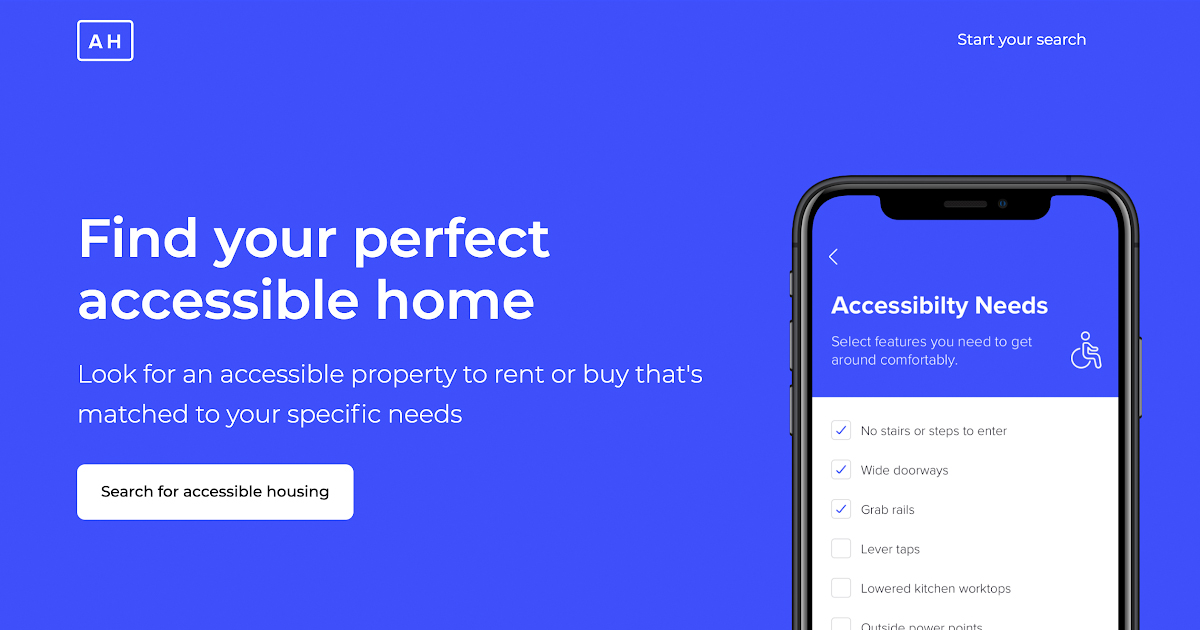Reflections from Red Badger's 2025 Partner Day
Dive into Red Badger's Latest Annual Partner Day and learn how alignment, strategic hires, and client trust are central to how we're creating shared...
Red Badger's digital product strategy uses a simple model that focuses on territory, desirability, feasibility and viability.

The last 18 months have drastically changed the way I think about developing digital products.
My background is in technology. I started as a software engineer working with a cross-functional team at Red Badger. At that time my thinking about a product was focused on what we had to build and how we were going to build it – very much the technical feasibility of product delivery.
Working closely with other disciplines on the team such as our User Experience Designers introduced me to other aspects of a product that had not crossed my mind. They encouraged me to question why we were building it in the first place.
As a result, I now truly appreciate the value a user-centric approach plays in building a great digital product.
Our work, however, was often applied after many aspects of the product were already assumed and agreed upon. Occasionally these assumptions were valid and sound, giving us a great foundation to do what we do best.
Other times these assumptions were just that: assumptions. We would unknowingly work on something that would never successfully meet the need of the customer, or be viable for the business due to fundamental assumptions that just weren’t true.
“Too many entrepreneurs and innovators execute ideas prematurely because they look great in presentations, make excellent sense in the spreadsheet, and look irresistible in the business plan…only to learn later that their vision turned out to be a hallucination. ”
As a direct response to this problem, Red Badger began developing our product strategy offering. The intent of this service is to involve ourselves much earlier in the product development timeline so that we can validate the risky assumptions that lead to unsustainable or underperforming products long before they are baked into the business plan and product roadmap.
Ultimately this saves our clients time and money; killing ideas that may seem great but are unsustainable, and finding the right product to build so that we can then build it right.
Reflecting on the risky assumptions that we encountered has helped me see digital products through a new lens. I now think about a product through a simplified model of desirability, feasibility and viability working in harmony within a territory of focus.
A territory might cover a given sector or industry. For example finance, housing, and retail. It might even be a problem space e.g. office productivity, wellbeing, or social mobility. From our experience a narrow territory helps to bring focus – for example, digital lending services targeting under-serviced individuals, mostly looking at business-to-customer products and some business-to-business products.
In November last year, Strategyzer released the book Testing Business Ideas which further validated this simplified model and gave us a number of new tools to draw upon when validating our assumptions. I highly recommend it if you are looking to develop a new business or product within your existing business.

We have found approaching product development in a way that considers proving desirability first, feasibility second and viability third leads to uncovering critical invalid assumptions sooner.
This enables pivotal decisions to be made earlier ultimately reducing risk and leading to developing a more robust, sustainable product.
Validating desirability first is often not instinctive, at least not in the industries we have worked with. With my technical background, my default is to think about what to build. I struggle not to solutionise and get excited about building the product, focusing on feasibility too early and often ignoring validating desirability all together. I want my product so surely all my customers will too, right? Wrong.
Validating desirability first makes sense because we are trying to understand human wants and needs. When compared to feasibility and viability, human needs are the least malleable and generally have the slowest rate of change over time. Finding what is desirable first serves as a great way to define a boundary for the other two aspects of a product with much less risk of it becoming invalid in the future.

It can also be beneficial to defer exploring feasibility until as late as possible.
Technology is changing more quickly than at any previous point in history. 10 years ago it was uncommon to use a cloud provider to host applications. Many of the tools we rely on today to make us more efficient did not exist.
I like to think that the bubble of feasibility is expanding over time as technology advances and opens up new opportunities. Similar to the Lean practise of deferring commitment, delaying feasibility exploration until as late as responsibly possible enables us to leverage advances in technology that did not previously exist or were too cost prohibitive to use.

Every successful product finds the right combination of desirability, feasibility and viability within its territory of focus.
Zooming out from this simplified model has led me to think about the products we build and the interactions between them within a territory.
One product may solve one particular customer problem, but collaborating products can create value chains that amplify the impact for your customer.
There are many untapped opportunities to create these value chains, but this often requires organisations to look outside of their own business. From cross-industry collaborations with other organisations to partner with competitors, there are many ways value chains can be built to ultimately create more value for customers.
This model has also helped me think about how we can apply this thinking to some of the biggest problems we face in the world. Recently we kicked off Mission Beyond. Through this we are adding one more point when considering viability:
Mission Beyond is focused on exploring territories that are critical to the long-term advancement of society. We are using the UK Grand Challenges and the UN Sustainable Development Goals as inspiration for territories to explore. We don’t intend to solve the whole mission or goal all at once. Instead, we are applying our product strategy approach to identify sustainable products that will bring value to customers and help us make progress.
As an example, we recently explored a territory focused around the ageing society Grand Challenge and the residential space. Within a few weeks and after filtering hundreds of ideas, we found a proposition that showed substantial heat to explore further. For our test, we called the product My Accessible Housing.

My Accessible Housing’s value proposition is:
“Because it's hard to find homes that meet specific accessibility needs, someone with accessibility needs would value a Zoopla-style home search specifically for their needs. ”
Through our desirability testing, we learnt that there is a strong indication of a desire for this product with a click through rate of 2.6% and conversion rate of 20.5%. Over 70% of impressions were with people over the age of 45. Due to the UK’s ageing population, this proposition could become stronger going forward.
The next steps are to start exploring this idea's feasibility and viability. Zoopla or Rightmove - perhaps a feature worth exploring further? Feel free to get in touch with us and we can share more detail.
As we do more work helping others on their product journey and keep pushing products to make a difference in the world I’m sure my thinking will evolve even further. These are exciting times and I’m looking forward to the value we will bring to our customers, their customers and the world.
Dive into Red Badger's Latest Annual Partner Day and learn how alignment, strategic hires, and client trust are central to how we're creating shared...
Discover five key lessons from implementing OpenTelemetry in micro services.
Larger businesses that partner with top-tier digital consultancies drive better customer experience through innovative, quality-focused approaches...
Add a Comment: